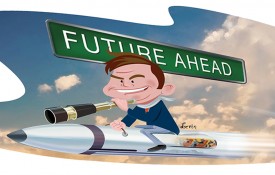The automotive industry is changing quickly, and car manufacturers anticipate the road ahead will likely lead toward an increase in driverless vehicles. Over 40 corporations are working on automated technology, with major manufacturers including Tesla, Toyota, BMW, Nissan, Ford, Audi, and GM all announcing that they’ll have driverless vehicles developed within a few years. Still, it’s hard for many people to imagine how driverless, or autonomous, vehicles will move safely and efficiently through our city streets.
As chairman and CEO of Parsons Corporation, I’m constantly thinking about how technology can positively impact infrastructure and our national defense and security, and how in turn it impacts people. As I commute home from the office, I am struck by the divergence between the state-of-the-art technology in my car and home, and a road that’s been largely the same since President Dwight Eisenhower created the interstate highway system.
It’s logical to expect that the same roads and traffic signals that were cutting-edge when we manually rolled down our windows with a crank will not be adequate to manage traffic in a connected future. We also do not have the luxury of time to conduct a series of analyses to figure this out. Cities around the world have already started testing driverless vehicles. Austin and Las Vegas are piloting low-speed automated shuttles to support local circulation in pedestrian-heavy areas, while places like Phoenix and Pittsburgh are allowing automated taxis to test their technology and business on public streets.
“Smart city” infrastructure will transform streets and intersections into data-sharing hubs for driverless vehicles to get a better vision of the conditions around them.
While these pilots and tests have given cities better insights into the technology, questions remain about how driverless vehicles will deliver the improved safety and increased efficiency that has been promised. The time to act is now. How will driverless vehicles interact with non-self-driving vehicles, pets, pedestrians, cyclists, scooters, and distracted drivers? Will driverless vehicles operate safely in the rain and snow? How will driverless vehicles make my commute faster and safer?
Answers to questions like these aren’t so much about the vehicles as about the streets they will drive on and their associated signals, speed limits, and other infrastructure. While driverless vehicles will have dozens of sensors, radars, and cameras that will provide a vast amount of data about objects and activities directly around them, they’ll need more information from farther away to anticipate traffic conditions throughout city streets, avoid conflicts at intersections, and anticipate human-driver actions.
This will be particularly important in the near term, when driverless vehicles will constitute a lower percentage of total vehicles on the road, minimizing the benefit of being able to share information with other driverless vehicles.
So how will the streets help driverless cars? “Smart city” infrastructure will transform streets and intersections into data-sharing hubs for driverless vehicles to get a better vision of the conditions around them. Sensors embedded in streets and mounted on streetlight poles will provide detailed traffic conditions throughout the city. Intelligent intersections will communicate with approaching driverless vehicles to identify optimal combinations of speed, fuel consumption, and routing. Vehicles and infrastructure will continuously communicate to optimize the operations of signals, streetlights, and other city resources around them.
Although cities already face the issue of too many deserving causes and not enough money, one great aspect about smart city technology is that it’s a good financial decision that pays dividends down the road, literally. Cities will be able to automate complex traffic-management tasks, allowing employees to use their time to work on higher-priority concerns. Citizens will save time commuting to work, leaving them more refreshed and productive at the office and with more quality time with loved ones. Productivity will increase, and more importantly, so will quality of life. That will attract more businesses and people to live and work in smart cities, boosting the local economy and making the infrastructure-investment worthwhile.
You can’t pack more than 24 hours in a day—but smart-city infrastructure allows people to find extra time in their busy schedules. Cities have started to understand these needs and are advancing smart infrastructure to support driverless vehicles. Denver, Detroit, and New York City are a few of many smart cities that are installing communication devices for connected and automated vehicles.
While cars are getting smarter and more automated, the key to unlocking a driverless-vehicle future lies in smart streets and smart cities. And while the automotive industry continues to advance the vehicle technology, our cities and communities must continue to advance smart infrastructure. Driverless vehicles will not only be driven by the technology inside them, but by the infrastructure around them.













































